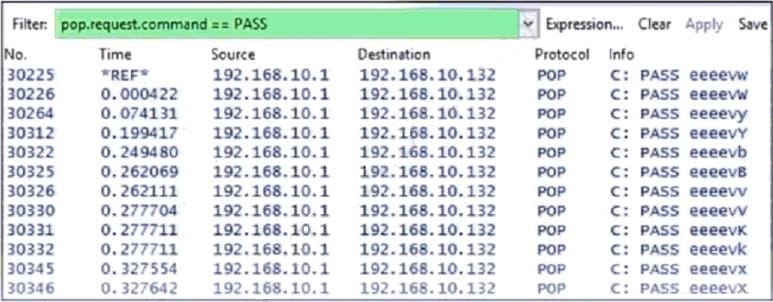leads4pass has updated Microsoft AZ-104 dumps issues! The latest AZ-104 exam questions can help you pass the exam! All questions are corrected to ensure authenticity and effectiveness! Download the leads4pass AZ-104 VCE dumps or PDF dumps: https://www.leads4pass.com/az-104.html (Total Questions: 408 Q&A AZ-104 Dumps)
Brain2dumps Exam Table of Contents:
- Latest Microsoft AZ-104 google drive
- Effective Microsoft AZ-104 Practice testing questions
- leads4pass Year-round Discount Code
- What are the advantages of leads4pass?
Latest Microsoft AZ-104 google drive
[Latest PDF] Free Microsoft AZ-104 pdf dumps download from Google Drive: https://drive.google.com/file/d/1CxGEZSat7nU19EhWVdZ3lvtTpBJHiEKs/
Share Microsoft AZ-104 exam questions for free
QUESTION 1
You have an Azure DNS zone named adatum.com. You need to delegate a subdomain named research.adatum.com to
a different DNS server in Azure. What should you do?
A. Create an PTR record named research in the adatum.com zone.
B. Create an NS record named research in the adatum.com zone.
C. Modify the SOA record of adatum.com.
D. Create an A record named “.research in the adatum.com zone.
Correct Answer: B
You need to create a name server (NS) record for the zone. References: https://docs.microsoft.com/enus/azure/dns/delegate-subdomain
QUESTION 2
You have a deployment template named Template1 that is used to deploy 10 Azure web apps. You need to identify
what to deploy before you deploy Template1. The solution must minimize Azure costs. What should you identify?
A. 10 App Service plans
B. one Azure Traffic Manager
C. five Azure Application Gateways
D. one App Service plan
E. one Azure Application Gateway
Correct Answer: D
You create Azure web apps in an App Service plan.
Reference:
https://docs.microsoft.com/en-us/azure/app-service/overview-hosting-plans
QUESTION 3
DRAG DROP
You have an Azure subscription that contains the following resources:
1.
a virtual network named VNet1
2.
a replication policy named ReplPolicy1
3.
a Recovery Services vault named Vault1
4.
an Azure Storage account named Storage1
You have an Amazon Web Services (AWS) EC2 virtual machine named VM1 that runs Windows Server You need to
migrate VM1 to VNet1 by using Azure Site Recovery.
Which three actions should you perform in sequence? To answer, move the appropriate actions from the list of actions
to the answer area and arrange them in the correct order.
Select and Place:
Correct Answer:
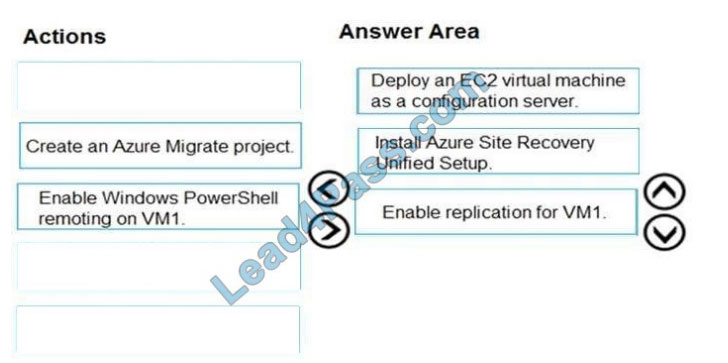
Step 1: Deploy an EC2 virtual machine as a configuration server Prepare source include:
Use an EC2 instance that\\’s running Windows Server 2012 R2 to create a configuration server and register it with your
recovery vault.
Configure the proxy on the EC2 instance VM you\\’re using as the configuration server so that it can access the service
URLs.
Step 2: Install the Azure Site Recovery Unified Setup.
Download Microsoft Azure Site Recovery Unified Setup. You can download it to your local machine and then copy it to
the VM you\\’re using as the configuration server.
Step 3: Enable replication for VM1.
Enable replication for each VM that you want to migrate. When replication is enabled, Site Recovery automatically
installs the Mobility service.
References:
https://docs.microsoft.com/en-us/azure/site-recovery/migrate-tutorial-aws-azure
QUESTION 4
HOTSPOT
You have an Azure Active Directory (Azure AD) tenant named contoso.onmicrosoft.com that contains the users shown
in the following table.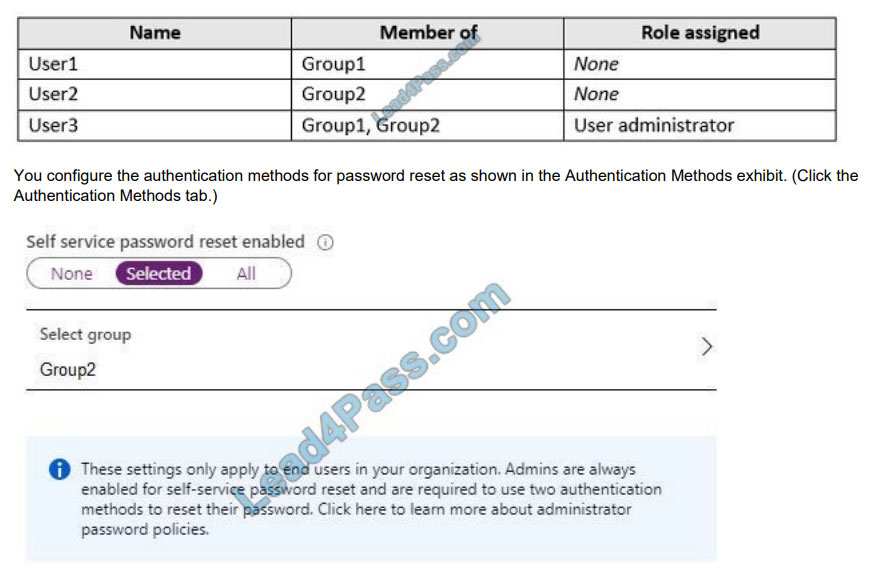
You configure the authentication methods for password reset as shown in the Authentication Methods exhibit. (Click the
Authentication Methods tab.)
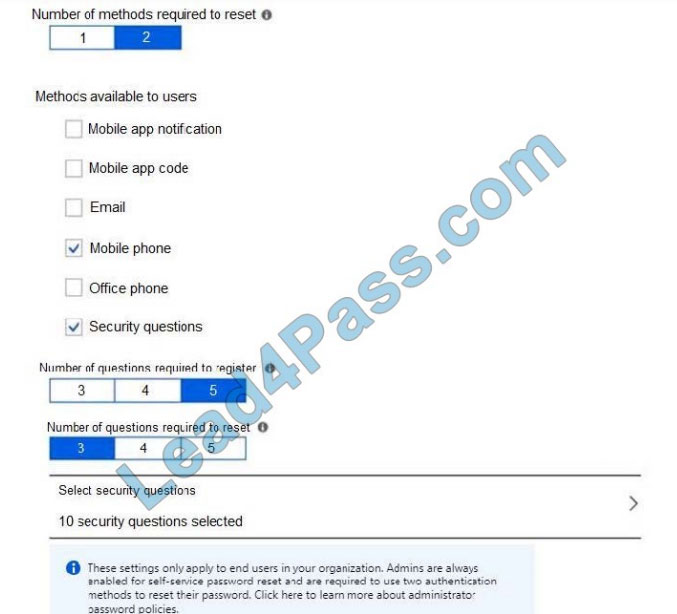
For each of the following statements, select Yes if the statement is true. Otherwise, select No.
NOTE: Each correct selection is worth one point.
Hot Area:
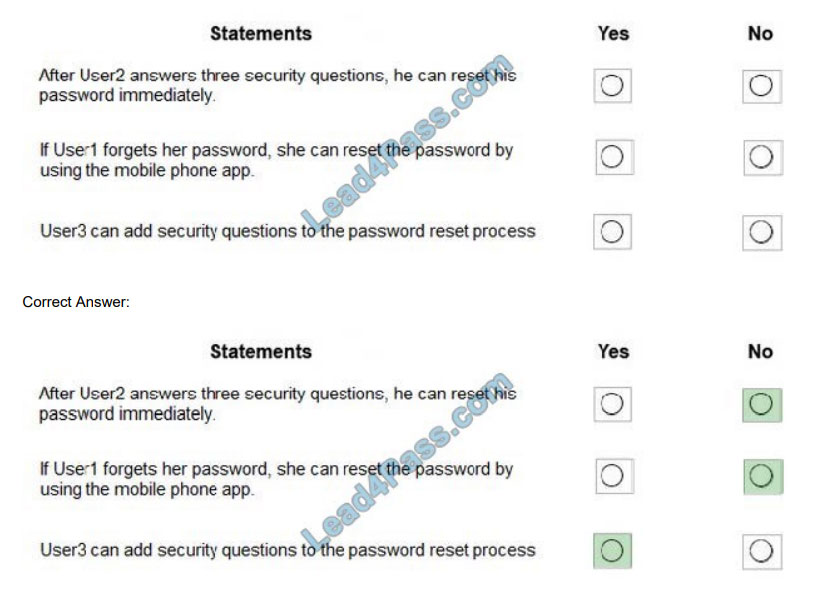
Box 1: No
Two methods are required.
Box 2: No
Self-service password reset is only enabled for Group2, and User1 is not a member of Group2.
Box 3: Yes
As a User Administrator, User3 can add security questions to the reset process.
Reference:
https://docs.microsoft.com/en-us/azure/active-directory/authentication/quickstart-sspr
https://docs.microsoft.com/en-us/azure/active-directory/authentication/active-directory-passwords-faq
QUESTION 5
HOTSPOT
You have an Azure subscription.
You plan to use Azure Resource Manager templates to deploy 50 Azure virtual machines that will be part of the same
availability set.
You need to ensure that as many virtual machines as possible are available in the fabric fails or during servicing.
How should you configure the template? To answer, select the appropriate options in the answer area.
NOTE: Each correct selection is worth one point.
Hot Area: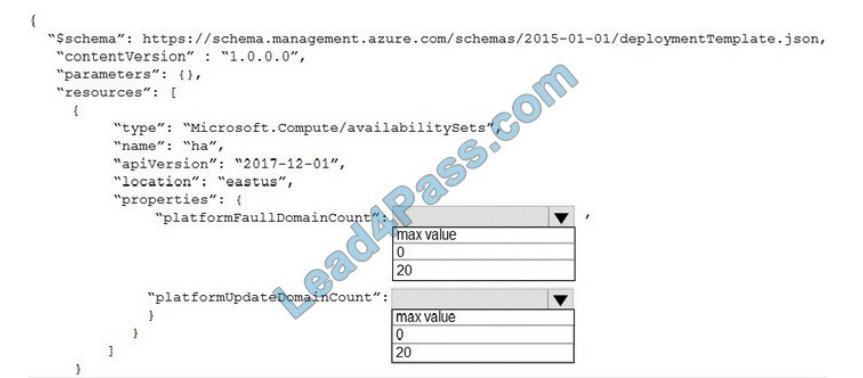
Correct Answer:
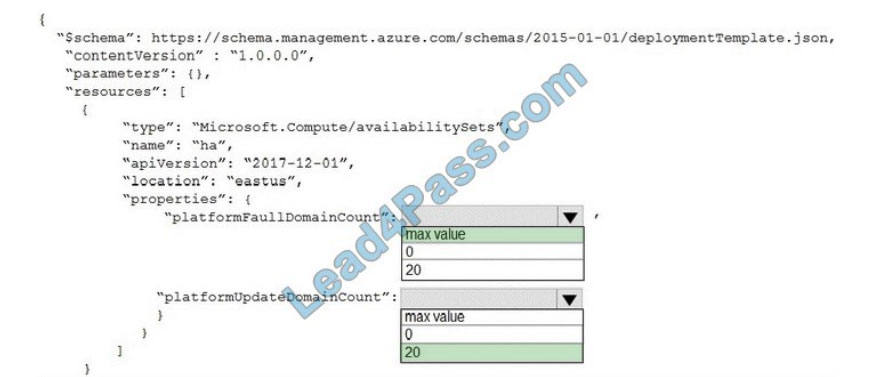
as per https://docs.microsoft.com/en-us/rest/api/compute/availabilitysets/createorupdate, you can only specify an integer, so 3 and 20 are the answers (not max, and for sure not 0) Request Body Name Required Type
Description properties.platformFaultDomainCount integer Fault Domain count. properties.platformUpdateDomainCount
integer Update Domain count. Use two fault domains. 2 or 3 is the max value, depending on which region you are in. Use
20 for platformUpdateDomainCount Increasing the update domain (platformUpdateDomainCount) helps with capacity
and availability planning when the platform reboots nodes. A higher number for the pool (20 is max) means that fewer of
their nodes in any given availability set would be rebooted at once.
References:
https://www.itprotoday.com/microsoft-azure/check-if-azure-region-supports-2-or-3-fault-domains-managed-disks
https://github.com/Azure/acs-engine/issues/1030
QUESTION 6
You have an on-premises network that contains a Hyper-V host named Host1. Host1 runs Windows Server 2016 and
hosts 10 virtual machines that run Windows Server 2016. You plan to replicate the virtual machines to Azure by using
Azure Site Recovery. You create a Recovery Services vault named ASR1 and a Hyper-V site named Site1.
You need to add Host1 to ASR1.
What should you do?
A. Download the installation file for the Azure Site Recovery Provider. Download the vault registration key. Install the
Azure Site Recovery Provider on Host1 and register the server.
B. Download the installation file for the Azure Site Recovery Provider. Download the storage account key. Install the
Azure Site Recovery Provider on Host1 and register the server.
C. Download the installation file for the Azure Site Recovery Provider. Download the vault registration key. Install the
Azure Site Recovery Provider on each virtual machine and register the virtual machines.
D. Download the installation file for the Azure Site Recovery Provider. Download the storage account key. Install the
Azure Site Recovery Provider on each virtual machine and register the virtual machines.
Correct Answer: A
Below are the steps you need to perform in this scenario. Refer to the link mentioned in the reference section.
Download the installation file for the Azure Site Recovery Provider To set up the source environment, you create a
Hyper-V site and add to that site the Hyper-V hosts containing VMs that you want to replicate. Then, you download and
install
the Azure Site Recovery Provider and the Azure Recovery Services agent on each host, and register the Hyper-V site in
the vault.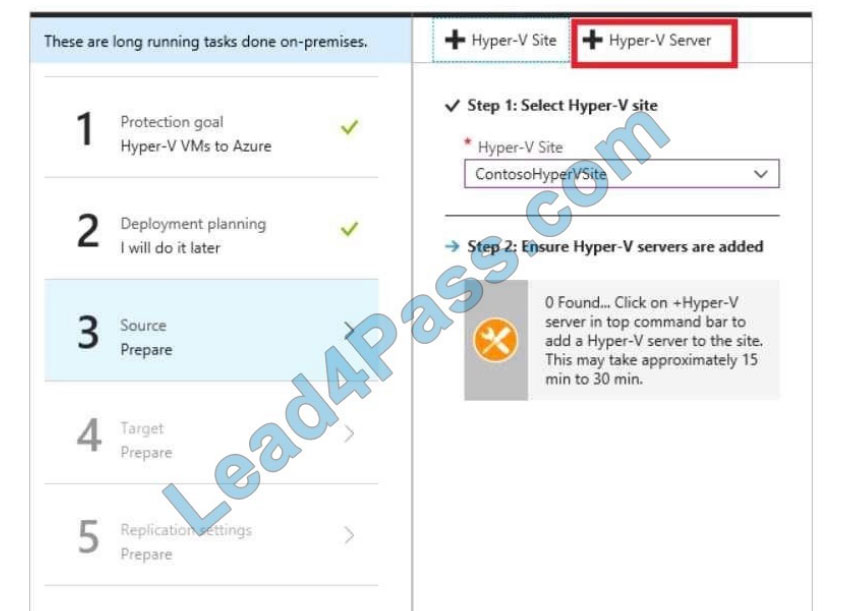
Download the vault registration key
Download the Vault registration key. You need this when you install the Provider. The key is valid for five days after you
generate it.
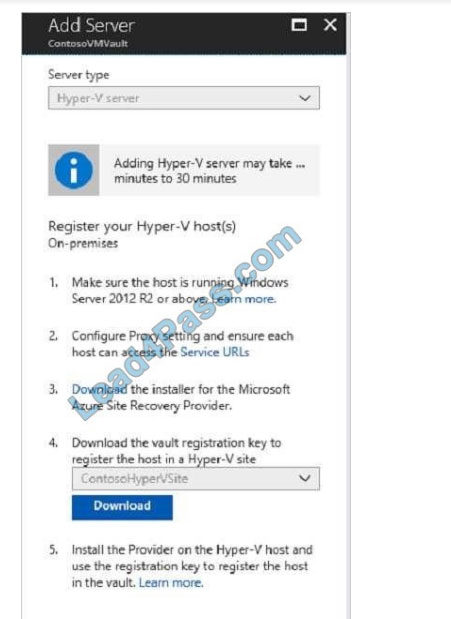
Install the Azure Site Recovery Provider on Host1.
Install the downloaded setup file (AzureSiteRecoveryProvider.exe) on each Hyper-V host that you want to add to the
Hyper-V site. Setup installs the Azure Site Recovery Provider and Recovery Services agent on each Hyper-V host.
Register the server
In Registration, after the server is registered in the vault, select Finish.
References:
https://docs.microsoft.com/en-us/azure/site-recovery/hyper-v-azure-tutorial
QUESTION 7
You have an Azure subscription named Subscription that contains the resource groups shown in the following table.
In RG1, you create a virtual machine named VM1 in the East Asia location.
You plan to create a virtual network named VNET1.
You need to create VNET, and then connect VM1 to VNET1. What are two possible ways to achieve this goal? Each
the correct answer presents a complete solution.
NOTE: Each correct selection is worth one point.
A. Create VNET1 in RG2, and then set East Asia as the location.
B. Create VNET1 in a new resource group in the West US location and then set West US as the location.
C. Create VNET1 in RG1, and then set East Asia as the location
D. Create VNET1 in RG1, and then set East US as the location.
E. Create VNET1 in RG2, and then set East US as the location.
Correct Answer: AC
A network interface can exist in the same, or different resource group, then the virtual machine you attach it to, or the
virtual network you connect it to. The virtual machine you attach a network interface to and the virtual network you
connect it to must exist in the same location, also referred to as a region. Note, Resource groups can span multiple Regions, but
VNets only can hold resources (VMs, Network Adapters) that exist in the same region.
So in this scenario, you need to create VNET1 in any RG and set the location as East Asia.
Reference:
https://docs.microsoft.com/en-us/azure/virtual-network/virtual-network-network-interface
QUESTION 8
You have an Azure subscription named Subscription1 that contains an Azure virtual network named VNet1. VNet1
connects to your on-premises network by using Azure ExpressRoute. You need to connect VNet1 to the on-premises
network
by using a site-to-site VPN. The solution must minimize costs.
Which three actions should you perform? Each correct answer presents part of the solution.
NOTE: Each correct selection is worth one point.
A. Create a local site VPN gateway.
B. Create a VPN gateway that uses the VpnGw1 SKU.
C. Create a VPN gateway that uses the Basic SKU.
D. Create a gateway subnet.
E. Create a connection.
Correct Answer: ABE
Create a Connection: You need to link the ExpressRoute gateway to the ExpressRoute circuit. After this step has been
completed, the connection between your on-premises network and Azure through ExpressRoute will be established.
Hence this is the correct option. Create a local site VPN gateway: This will allow you to provide the local gateway settings,
for example, public IP and the on-premises address space, so that the Azure VPN gateway can connect to it. Hence this
is
correct option.
Create a VPN gateway that uses the VpnGw1 SKU: The GatewaySku is only supported for VpnGw1, VpnGw2,
VpnGw3, Standard, and HighPerformance VPN gateways. ExpressRoute-VPN Gateway coexist configurations are not
supported
on the Basic SKU. The VpnType must be RouteBased. Hence this is the correct option.
https://docs.microsoft.com/en-us/azure/vpn-gateway/vpn-gateway-howto-site-to-site-resource-manager-portal
https://docs.microsoft.com/en-us/azure/expressroute/expressroute-howto-coexist-resource-manager
https://docs.microsoft.com/en-us/azure/expressroute/expressroute-howto-linkvnet-arm
QUESTION 9
HOTSPOT
You have an on-premises data center and an Azure subscription. The data center contains two VPN devices. The
subscription contains an Azure virtual network named VNet1. VNet1 contains a gateway subnet.
You need to create a site-to-site VPN. The solution must ensure that if a single instance of an Azure VPN gateway fails,
or a single on-premises VPN device fails, the failure will not cause an interruption that is longer than two minutes.
What is the minimum number of public IP addresses, virtual network gateways, and local network gateways required in
Azure? To answer, select the appropriate options in the answer area.
NOTE: Each correct selection is worth one point.
Hot Area: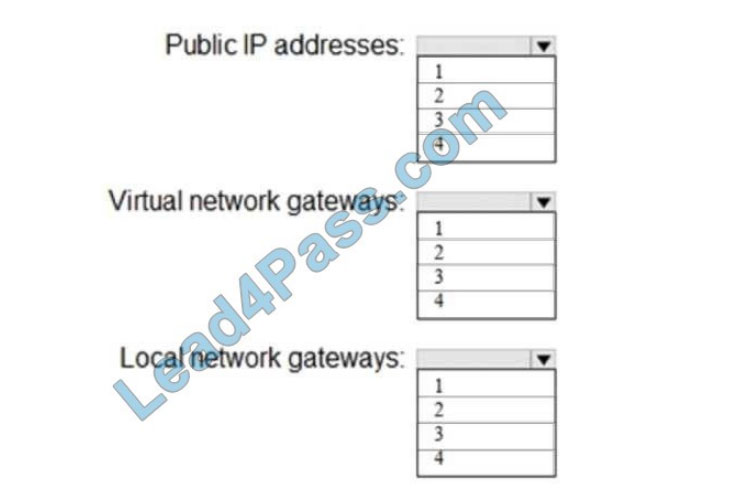
Correct Answer:
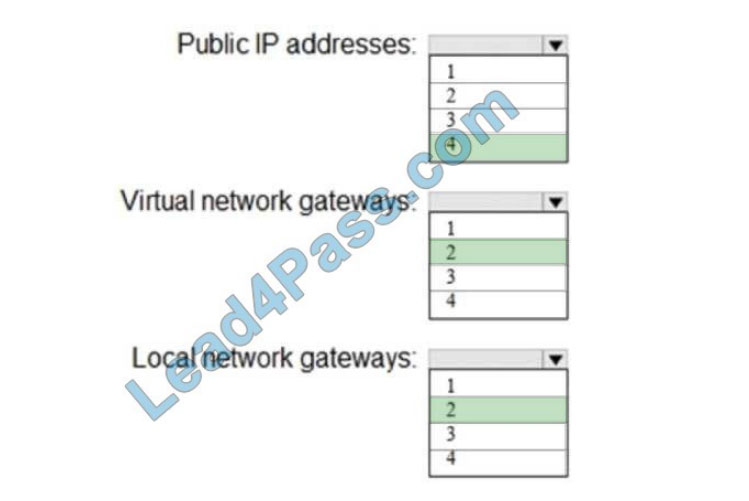
Box 1: 4
Two public IP addresses in the on-premises data center, and two public IP addresses in the VNET. The most reliable option is to combine the active-active gateways on both your network and Azure, as shown in the diagram below.

Box 2: 2
Every Azure VPN gateway consists of two instances in an active-standby configuration. For any planned maintenance
or unplanned disruption that happens to the active instance, the standby instance would take over (failover)
automatically,
and resume the S2S VPN or VNet-to-VNet connections.
Box 3: 2
Dual-redundancy: active-active VPN gateways for both Azure and on-premises networks Reference:
https://docs.microsoft.com/en-us/azure/vpn-gateway/vpn-gateway-highlyavailable
QUESTION 10
You have an Azure subscription that contains the resources shown in the following table.
You need to deploy Application1 to Cluster1. Which command should you run?
A. az acr build
B. az aks create
C. docker build
D. kubectl apply
Correct Answer: A
QUESTION 11
You are evaluating the connectivity between the virtual machines after the planned implementation of the Azure
networking infrastructure. For each of the following statements, select Yes if the statement is true. Otherwise, select
No.
Hot Area: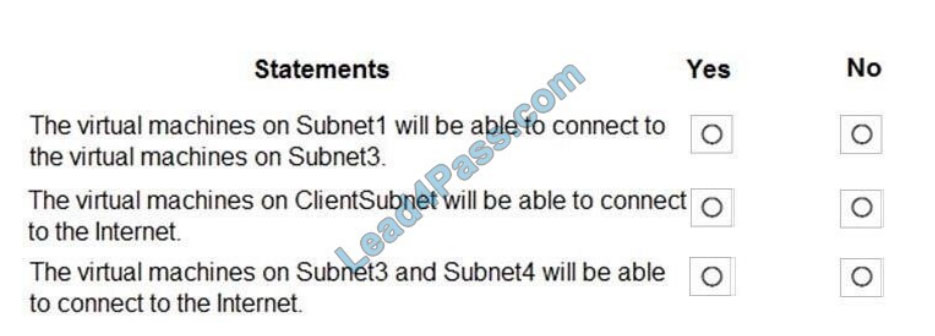
Correct Answer:
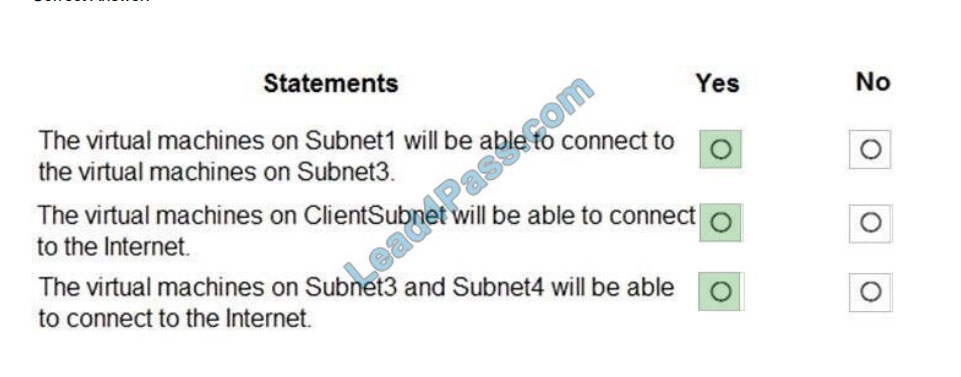
QUESTION 12
Note: This question is part of a series of questions that present the same scenario. Each question in the series contains
a unique solution that might meet the stated goals. Some question sets might have more than one correct solution,
while others might not have a correct solution. After you answer a question in this section, you will NOT be able to return
to it. As a result, these questions will not appear on the review screen. You have a computer named Computer1 that has
a point-to-site VPN connection to an Azure virtual network named VNet1. The point-to-site connection uses a self-signed certificate. From Azure, you download and install the VPN client configuration package on a computer named
Computer2. You need to ensure that you can establish a point-to-site VPN connection to VNet1 from Computer2.
Solution: You modify the Azure Active Directory (Azure AD) authentication policies. Does this meet this goal?
A. Yes
B. No
Correct Answer: B
Instead, export the client certificate from Computer1 and install the certificate on Computer2.
Note:
Each client computer that connects to a VNet using Point-to-Site must have a client certificate installed. You generate a
client certificate from the self-signed root certificate and then export and install the client certificate. If the client
certificate
is not installed, authentication fails.
Reference:
https://docs.microsoft.com/en-us/azure/vpn-gateway/vpn-gateway-certificates-point-to-site
QUESTION 13
HOTSPOT
You have an Azure subscription named Subscription1.
You plan to deploy an Ubuntu Server virtual machine named VM1 to Subscription1. You need to perform a custom
deployment of the virtual machine. A specific trusted root certification authority (CA) must be added during the
deployment.
What should you do? To answer, select the appropriate options in the answer area.
NOTE: Each correct selection is worth one point.
Hot Area: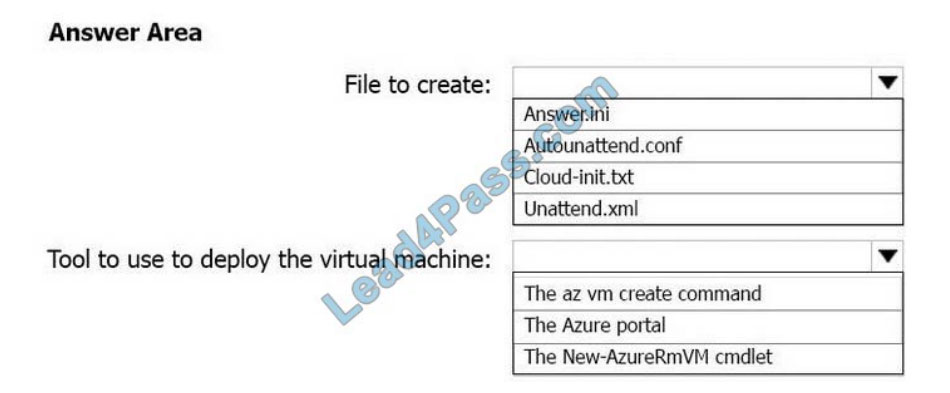
Correct Answer:
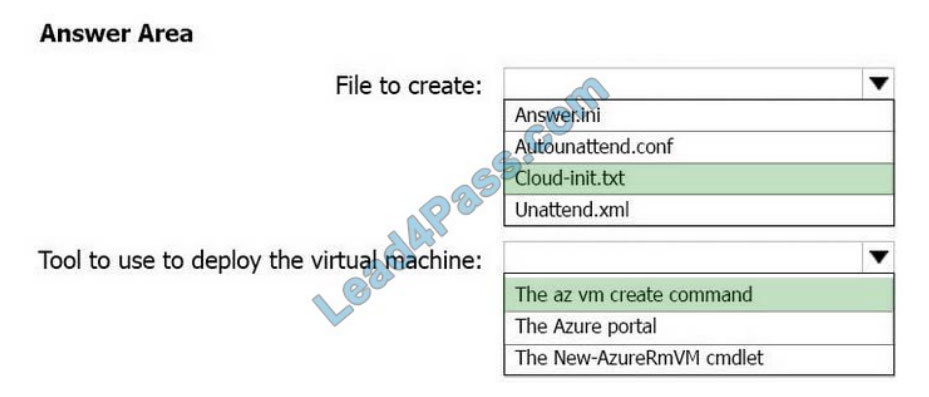
Box 1: Cloud-init.txt
Cloud-init.txt is used to customize a Linux VM on the first bootup. It can be used to install packages and write files, or to
configure users and security. No additional steps or agents are required to apply your configuration.
Box 2: The az VM create command
Once Cloud-init.txt has been created, you can deploy the VM with az VM create cmdlet, sing the — custom data
parameter to provide the full path to the cloud-init.txt file.
References:
https://docs.microsoft.com/en-us/azure/virtual-machines/linux/tutorial-automate-vm-deployment
Latest leads4pass Microsoft dumps Discount Code 2020

About The leads4pass Dumps Advantage
leads4pass has 7 years of exam experience! A number of professional Microsoft exam experts! Update exam questions throughout the year! The most complete exam questions and answers! The safest buying experience! The greatest free sharing of exam practice questions and answers!
Our goal is to help more people pass the Microsoft exam! Exams are a part of life, but they are important! In the study, you need to sum up the study! Trust leads4pass to help you pass the exam 100%!
Summarize:
This blog shares the latest Microsoft AZ-104 exam dumps, AZ-104 exam questions, and answers! AZ-104 pdf, AZ-104 exam video!
You can also practice the test online! leads4pass is the industry leader!
Select leads4pass AZ-104 exams Pass Microsoft AZ-104 exams “Microsoft Azure Administrator”. Help you successfully pass the AZ-104 exam.
ps.
Get Microsoft Full Series Exam Dumps: https://www.fulldumps.com/?s=Microsoft (Updated daily)
Get leads4pass Microsoft Role-based exam dumps: https://www.leads4pass.com/role-based.html
Latest update leads4pass AZ-104 exam dumps: https://www.leads4pass.com/az-104.html (408 Q&As)
[Q1-Q12 PDF] Free Microsoft AZ-104 pdf dumps download from Google Drive: https://drive.google.com/file/d/1CxGEZSat7nU19EhWVdZ3lvtTpBJHiEKs/

